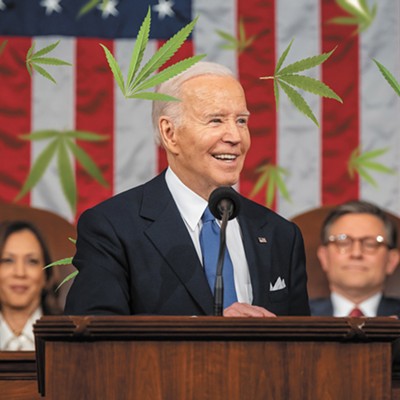On Monday, supporters of the local gay community plan to march north on Washington Street, then cut west over to Spokane City Hall. There, some will speak in favor of a city resolution to support Washington’s new marriage-equality law.
Councilman Mike Allen supports the resolution.
“For me, it’s very difficult to say all men are created equal and not give that equity to everyone,” he says.
Still, a recent spate of nonbinding resolutions leaves him annoyed. Marriage equality. A resolution supporting medical marijuana. A resolution against the U.S. Supreme Court decision Citizens United, which allowed special interest money to pour into political campaigns.
“We have spent hours and hours so far on these resolutions,” Allen says. “I’d much rather focus on the business of the city and the stuff we can affect the outcomes of.”
As of April 6, the council had considered 36 resolutions, according to city spokeswoman Marlene Feist. At this pace, the council stands to consider about 145 resolutions this year, a 40-percent increase over the 103 resolutions considered in 2011.
A resolution is a tool used by legislators to decide on anything that doesn’t have to be codified or made into law, Feist says. And they’re not all position statements. The council will use resolutions for routine drudgery: accepting reports, setting hearing dates, confirming the mayor’s personnel appointments.
But Council President Ben Stuckart likes the rabble-rousing angle.
“People in Spokane aren’t used to an active council, and this is part of our role taking leadership in the city,” Stuckart says. “I think leaders have a responsibility to speak on the large issues of the day.”
The council president says resolutions bring people into the political process. Consider the resolution and subsequent public hearing opposing the demolition of the Jensen-Byrd warehouse building in the University District.
“That night we had 36 people show up to testify, and the majority of them were testifying against tearing it down,” Stuckart says. “They didn’t have another avenue for voicing their opinions, so it was important.
“In every issue we have discussed, we have a slew of people coming forth to testify.”
In Seattle, in order to keep the number of resolutions manageable, City Council President Sally Clark says her council uses two general rules.
First, a resolution has to have something to do with the city’s quality of life. Second, it has to actually have some kind of practical outcome.
Even with those standards, “You can construct pretty big doors for these things to go through,” Clark says.
Resolutions aren’t unique to either Spokane or Seattle, says Kevin Pirch, assistant professor of government at Eastern Washington University.
“You can show your voters that you’re doing something” through resolutions, Pirch says.
“They might be good in signaling to the people who do have control over the issues.”
And people who control issues sometimes do take them seriously. When the Jensen-Byrd resolution came before the council, executives from Campus Advantage, the company that owns the property and plans to replace the warehouse with modern apartments, flew up from Texas to testify.
But others, like Councilman Steve Salvatori, are feeling fatigue from the parade of debates.
“I pride myself on returning all my phone calls and email within 24 emails,” says Salvatori, who co-sponsored the Jensen- Byrd resolution. But after people heard about the resolution supporting gay marriage, which will be considered April 16, several hundred calls and emails making pro and con arguments flooded Salvatori.
“Do the math on 400, if each one takes two minutes?” he asks, referring to phone calls and emails.
Salvatori agrees with Allen that some resolutions have direct relevance for Spokane. Both insist the Jensen-Byrd discussion made sense. But Salvatori called Councilwoman Amber Waldref’s resolution decrying the Citizens United U.S. Supreme Court decision “totally nonproductive.”
“I think we’re kind of using City Council as an editorial board,” he says.
He brings up another resolution that’s been floated, an idea by Stuckart to oppose a potential increase in the number of coal trains heading through Spokane to western ports, and eventually China. It’s not useful, he says, “unless we’re looking at a resolution to send to the City of Longview, asking trains to become covered.”
Stuckart, the council president, insists that the sweeping debates aren’t interfering with the council’s work time.
“My list of things I’m working on is 25 items long, and I’m working on every one of them every day, trying to move each of them forward, so we’re not just focusing on these resolutions,” he says.
“But I think, after the pushback, you’ll see [fewer] resolutions coming forward,” he adds.
Including the coal train resolution. “People are concerned about the issue, but I think this council’s probably going to be more comfortable writing a letter . . . versus a resolution where we have 40 people testify,” Stuckart says.




















